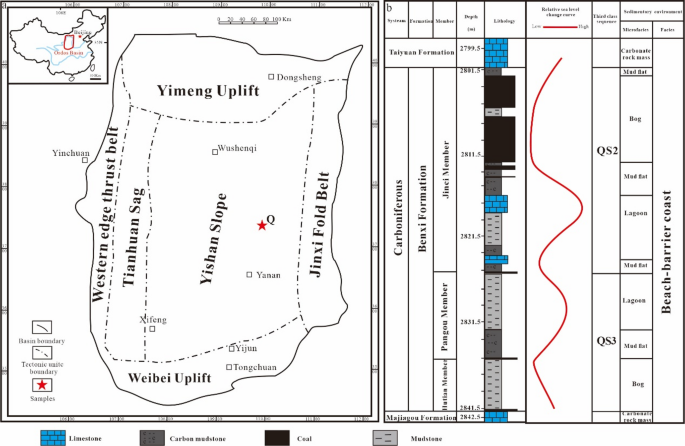Influence of vertical sedimentary environment on the formation of the Benxi coal seam
Coal-rock sedimentary facies of the Benxi coal seam
Qualitative and quantitative maceral results are shown in Table 1, where it can be seen that coal from the Benxi coal seam is mainly composed of vitrinite (75.58%), with less amounts of inertinite (12.39%) and liptinite (0.06%)32,40,41,42 (Fig. 7), and also contains small amounts of clay minerals and pyrite. The 12 coal samples in this seam are mainly bright and semi-bright coal, and the Ro is about 1.4%. Therefore, according to the international coal classification standard ISO11760 (2005), due to 0.5% < Ro < 2%, the coal rank of the coal samples in our study is medium rank bituminous coal. In addition, according to Table 1, the volatile content of the 12 coal samples is mostly about 14%, and the volatile content of the top coal sample is relatively high. Therefore, with reference to “ASTM D388-23: Standard Classification of Coals by Rank”, they also can be classified as medium-low volatile bituminous coal. Because vitrinite mainly results from the gelatinization of plant tissues in a water-covered reducing environment, it indicates a relatively stable water level and reducing environment for coal formation. In contrast, inertinite is formed by fungal decomposition and wildfire burning of similar plant tissue under dry conditions, reflecting a lower water level and oxidizing environment46,47,48. Therefore, a higher vitrinite content and lower inertinite content indicates that the sedimentary environment of the Benxi coal seam was a partially reducing water-covered peat swamp.
Triangle diagram of macerals of 8 # coal. It is found from the figure that there is almost no liptinite.
Moreover, the use of coal petrological parameters (e.g., GI, TPI, VI, and GWI) can provide an enhanced understanding of the overall sedimentary environment of seam Benxi coal49,50. Diessel51 first proposed the GI‒TPI coal facies diagram, and the use of GI and TPI to determine coal-forming conditions. He interpreted the GI to be the ratio of the gelation component to the non-gelation component, reflecting the dryness or humidity of the coal-forming environment; that is, the change in water level in the coal-forming swamp and degree of gelation of plant remains. A higher GI value equates to a more humid peat-forming environment and deeper overlying water, whereas a drier peat-formation environment results in a lower GI value. The TPI is used to reflect the degree of transport, degradation, and oxidation of plant debris or cells and the degree of preservation of plant cell structure. A low TPI indicates intense degradation and a poorly preserved structure, whereas a high TPI indicates a low intensity of degradation and well preserved plant cells52. In this paper, a GI‒TPI facies diagram (Fig. 8a) was established according to these GI and TPI parameters. From this diagram, it can be observed that all coal sample parameter points essentially plotted in open-water swamp facies (e.g., tidal marsh), except for sample Q36-9 from a depth of 2811.59 m, which plotted in the moist forest swamp facies. Coal in the upper layer formed under deeper water, while coal in the middle and lower layers formed under shallower water. The overall GI is 1‒10, indicating a high gelation index for this coal seam, along with a swamp-like sedimentary environment characterized by deep overlying water, weak hydrodynamic conditions, and low plant accumulation rate. The TPI is mostly < 1, indicating that the plant cell structure has been destroyed to a certain extent, the degree of gelation is high, and the reducing power of the sedimentary environment was high.
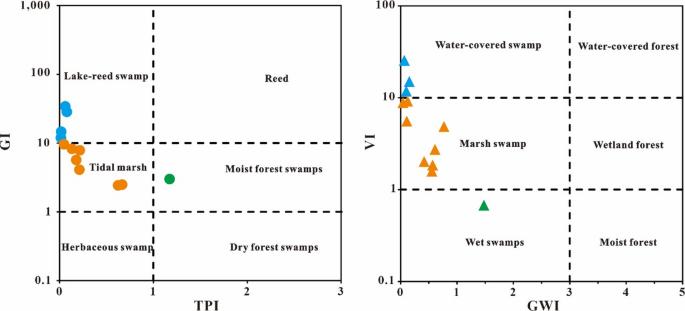
Coal facies diagram of 8 # coal in Benxi Formation, Ordos Basin. (a) GI-TPI coal facie diagram; (b) VI-GWI coal facie diagram.
The VI and GWI, defined by Calder et al.53are derived by adding stable macerals and minerals to the TPI/GI ratio proposed by Diessel51and reflect the dynamic groundwater characteristics of the original coal-forming environment. The VI reflects the preservation degree of coal-forming vegetation and its affinity with herbaceous or woody plants; a VI of < 1 indicates that the coal-forming plants were herbaceous or aquatic plants, whereas a VI > 1 indicates an affinity with woody plants35. The GWI is used to indicate changes in groundwater level, reflecting the degree of control of groundwater on the original coal-forming environment and its mineral content. A higher GWI equates to stronger degradation and higher mineral input of coal macerals34,53and stronger dynamic groundwater conditions. From the GWI‒VI facies diagram shown in Fig. 8 (b), it can be seen that the parameter values are essentially located in two areas: water-covered swamp and marsh swamp. The VI values of most samples are > 1, indicating that the coal-forming plants were mainly woody plants, and the GWI values are mostly < 1, indicating generally weak hydrodynamic conditions35.
In summary, the environment of the coal-forming period corresponding to the Benxi coal seam was a water-covered moist peat swamp with generally weak hydrodynamic conditions. However, through the study of vertical changes in macroscopic coal characteristics, maceral content, and coal-facies characteristics, it is evident that there are certain differences in the sedimentary environment recorded with changing depth in the coal seam.
Changes in sedimentary environment indicated by changing ash content
Coal ash is composed of oxides and salts of various elements such as Si, Al, and Fe. During the process of precipitation or migration in peat swamps, these elements are affected by factors such as water oxidation state, pH, hydrodynamic conditions, and salinity. Therefore, the composition of coal ash can reflect certain changes in the coal-forming environment54. From Fig. 3, it can be seen that the ash content gradually decreases from bottom to top within the drill core, and there is also a trend of high values at both ends of the core and low values in the middle. The ash content of the lower layer is higher than that of the upper layer, and shows no obvious change. The ash index is expressed as (SiO2 + Al2O3)/(Fe2O3 + CaO + MgO); a weakly reducing environment is dominated by SiO2 and Al2O3, and a strongly reducing environment is dominated by Fe2O3, CaO, and MgO; hence, the ash index is inversely proportional to reducibility55. From the data presented herein, it is evident that the lower layer and very top of the core mainly correspond to an oxidizing environment, with strong hydrodynamic force, bringing large amounts of terrestrial debris, resulting in a higher ash content. In contrast, the upper layer mainly corresponds to a reducing environment, with relatively stable water, resulting in a low ash content.
Changes in sedimentary environment indicated by changing sulfur content
Total sulfur in coal seams includes organic sulfur and inorganic sulfur. Organic sulfur mainly comes from coal-forming plants, and inputs of inorganic sulfur are mainly controlled by the aqueous environment during deposition. Usually, when the reducibility of a peat swamp is strong, sulfur-rich coal forms54. The sulfur in the samples obtained herein was mainly organic sulfur (Fig. 3), indicating that the depositional area comprised a partially reducing environment. In addition, in the lower layer of the coal seam, the inorganic sulfur content was high and organic sulfur content was low, indicating that strong hydrodynamic force and an oxidizing aqueous environment. In contrast, in the upper layer of the coal seam, the inorganic sulfur content was low, and organic sulfur content was high, indicating weak hydrodynamic force, and a generally reducing aqueous environment.
Changes in sedimentary environment indicated by changing coal petrological characteristics
Coal type is the most direct material manifestation of coal sedimentary facies. Different coal types can reflect different geochemical, hydrodynamic, water-cover, and burial conditions in peat swamps during coal-forming periods. The Benxi coal seam formed in a wet peat swamp environment with overlying water. In the early stage of coal formation, organic matter was deposited and then overlain with water. Therefore, a reducing‒weakly oxidizing environment existed, leading to good gelation, high vitrinite content, and low inertinite content; thus, Benxi coal mainly comprises bright coal and semi-bright coal (Fig. 2). According to observed changes with depth, the lower layer of the Benxi coal seam is mainly semi-bright coal, containing a thin layer of bright coal and argillaceous bands, and the upper layer is mainly bright coal, with the topmost layer being semi-bright coal. These changes are mainly a result of the ancient geographical environment. In the early and latest stages of peat formation, the deposition of organic matter occurred under oxidizing conditions, the GI value was low (Table 2), and the degree of gelation was insufficient. In the middle stage of peat formation, the swamp conditions changed, and the deposition of organic matter occurred under highly reducing conditions and high levels of water cover, leading to a high degree of gelation (Table 2) and high vitrinite content. Therefore, the upper coal seam is dominated by bright coal.
Microscopic coal components are good indicators of the coal-forming environment. In general, plant debris in a humid, reducing environment mainly generates vitrinite via the gelatinization process, while in a dry, oxidizing environment, it mainly generates inertinite by the fusinization process54. Through the analysis of macerals within Benxi coal (Figs. 4 and 9; Table 1), it can be seen that in the lower coal seam, the vitrinite content is relatively low, inertinite content is relatively high, and maceral content changes greatly within this lower layer. This indicates that the hydrodynamic force was strong, sedimentary environment was unstable, gelation was weak, and environment was oxidizing during the development of this part of the coal seam. In the upper coal seam, the vitrinite content is relatively high, inertinite content is relatively low, and the maceral content changes little within this upper layer. This shows that the period is the oxidation environment of water retention, the condition of overlying water is better, and the gelatinization is better. The content of vitrinite in the topmost layer of the coal seam decreased again, while the content of inertinite increased, indicating that the environment changed from reducing to oxidizing at this time, and the transgression occurred, accompanied by enhanced hydrodynamic force.

Vertical distribution sequence of coal-forming environment indicator parameters of 8 # coal in Benxi Formation. The indication parameters mainly include vitrinite, inertinite, F/M, OI and V/I.
In addition, the V/I proposed by Harvey et al.36 can also intuitively reflect the degree of water cover of coal peat swamps, and dry versus wet climate conditions. In an environment of high temperature and partial oxidation, fusinization is dominant, and the content of inertinite in coal macerals increases. In a warm and humid, partially reducing environment, gelatinization is dominant, and the vitrinite content increases. According to V/I values, coal-forming environments can be divided into four types: class I: V/I > 4, representing strong overlying deep water; class II: 1 < V/I ≤ 4, representing extremely humid-covered water; class III: 0.25 < V/I ≤ 1, representing wet-weak water cover; class IV: V/I ≤ 0.25, indicating a dry—high dry environment, where there have been fires. The V/I value gradually increases from the bottom to top of the Benxi coal seam in the study area (Fig. 9). In the lower layer, the V/I value is low, degree of water coverage is low, with some exposure to an oxidizing environment; the V/I value of the upper layer is much larger than 4, so the upper layer was completely covered with water, and the coal-forming environment was reducing. Therefore, the coal seam presents a pattern of oxidation‒reduction‒oxidation from bottom to top.
The OI value can also reflect the redox conditions of coal peat, wherein a higher OI value equates to a stronger degree of oxidation. In general, an OI > 1 represents an oxidizing environment, and an OI < 1 represents a reducing environment37. According to the data presented herein (Fig. 9; Table 2), the OI value is < 1 throughout the Benxi coal seam, indicating a partially reducing environment, supporting the overall sedimentary environment described above. However, there is a certain fluctuation from bottom to top through the coal seam. The OI values of the lower layer are higher, representing a partially oxidized environment, and the fluctuation is relatively large, indicating strong hydrodynamic force and substantial changes in water coverage. The OI values of the upper layer are low, indicating a partially reducing environment. The OI value then increases slightly at the very top of the coal seam, indicating a return to a partially oxidizing environment.
The ratio of skeletal components to matrix components and detrital components in coal-forming plants (F/M) can reflect the fluidity of swamp water and degree of plant fragmentation35,37. An F/M value > 1 indicates a stagnant environment with weak water flow activity, whereas an F/M value < 1 indicates an active aqueous environment with strong water flow. The F/M values of the lower layer of the Benxi coal seam are < 1, indicating that the sedimentary environment was an active aqueous environment with strong water flow, accompanied by the input of terrigenous clastic material; hence, the ash yield of this layer is relatively high (Fig. 3). In contrast, the F/M values in the upper layer are much larger than 1, indicating that the sedimentary environment had stagnant water with weak hydrodynamic conditions, and the water body was relatively stable. The F/M value at the very top of the coal seam is < 1, marking a return to an active aqueous environment, with accompanying higher ash yield (Fig. 9).
In summary, Benxi coal of the Benxi Formation in the Ordos Basin is a peat-swamp sedimentary facies, formed under partially reducing overlying water and weak hydrodynamic conditions. In the vertical direction, owing to the influence of sea-level change, the ash content gradually decreases from bottom to top, and the content of vitrinite gradually increases. This indicates an oxidizing aqueous environment with strong hydrodynamic conditions during deposition of the lower layer of the coal seam, and a reducing waterlogged environment during deposition of the upper layer of the coal seam. The very top layer of the coal seam marks a return to oxidizing conditions.
Reservoir development characteristics and controlling factors
Influencing factors of coal reservoir properties
The reservoir space and properties of coal have an important influence on the occurrence of coalbed methane. Therefore, it is of great significance to study the influencing factors of reservoir properties.
Ash content and fixed carbon content have an effect on the storage properties of coal. According to Fig. 10, ash content shows a significant negative correlation with porosity, while fixed carbon content shows a significant positive correlation with porosity. The main reason behind this is that an increase in ash content reflects large amounts of supplementary terrestrial debris, which continuously fills the primary pores of the coal and increases the mineral content of the coal. Hence, the continuity of pores can be destroyed, and the total pore volume of the coal can be reduced. Therefore, ash content and fixed carbon content can affect the reservoir properties of coal.
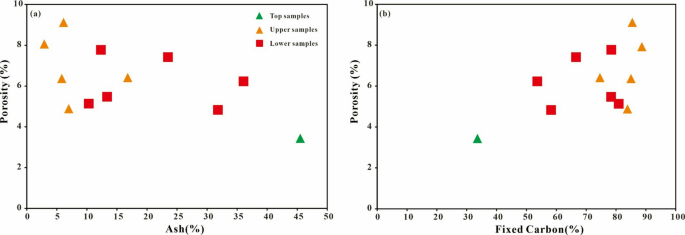
Correlation between ash content, fixed carbon content and porosity. (a) Correlation between ash and porosity; (b) Correlation between fixed carbon and porosity.
It has been confirmed by the data presented herein (Fig. 3) that the coal ash yield in different parts of the same coal seam changes substantially in the vertical direction. The ash content in the lower layer is higher than that in the upper layer, which indirectly indicates that the pores in the upper layer are well developed. Therefore, the upper layer is conducive to the storage and migration of coalbed methane and performs better as a reservoir.
In addition to the influence of ash and fixed carbon contents on reservoir performance, the sedimentary environment also exerts a certain control on pore development and reservoir properties. For samples of similar metamorphic grade, the coal-forming environment, as the main controlling factor affecting the macerals and industrial components of coal reservoirs, can affect the pore structure characteristics by influencing coal composition. Different coal-forming environments contain different plant assemblages, hydrodynamic conditions, and mineral supplies, which will inevitably affect the pore structure characteristics of the resultant coal. Therefore, it is important to discuss the controlling effect of the coal-forming environment on the pore characteristics of coal reservoirs. According to the data presented herein, the coal-forming sedimentary environment changed with depth through the Benxi coal seam; hence, the corresponding coal facies will also change with depth. To discover which type of coal facies controlled the pore structure of the Benxi coal as comprehensively as possible, we analyzed correlations between the four parameters of TPI, GWI, V/I, and F/M and the porosity, specific surface area, total pore volume, and other parameters obtained via the Hg intrusion experiment; this permitted a determination of the coal facies index that had the greatest influence on the pore structure.
It was found that not all coal facies parameters had an impact on pore structure characteristics. Figure 11 (a) shows that a correlation between TPI and total pore volume was not evident, indicating that the preservation of plant cells had little effect on these coal pores. According to Fig. 11 (b-c), the correlations between F/M and total pore volume, and VI and total pore volume, were also weak, indicating that pore structure was not greatly affected by vegetation type or bone base ratio.
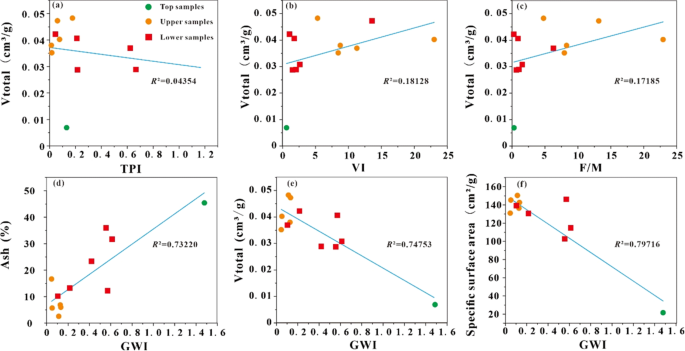
The correlation between coal facie parameters and ash content, total pore volume and specific surface area. (a) Relationship between total pore volume and TPI; (b) Relationship between total pore volume and VI; (c) Relationship between total pore volume and F/M; (d) The relationship between ash and GWI; (e) The relationship between total pore volume and GWI; (f) The relationship between specific surface area and GWI.
The GWI can be used to reflect changes in peat accumulation rate, groundwater level, and terrigenous debris and mineral contents. The correlations between pore characteristic parameters and GWI were analyzed (Fig. 11d‒f) and it was found that GWI had a significant positive correlation with ash content, and significant negative correlations with pore specific surface area and total pore volume. This can be explained as follows: an increase in GWI reflects an increase in the water level of the peat swamp; at this time, the hydrodynamic force is enhanced, resulting in stronger degradation of macerals and increased mineral input, in turn leading to an increase in ash content; these exotic minerals will fill the larger primary pores in coal, resulting in negative correlations between pore specific surface area and GWI, and between total pore volume and GWI.
In general, therefore, the coal facies parameter that has the greatest influence on pore structure characteristics in this area is the GWI, which can reflect changes in water level and mineral input. According to data presented herein, the GWI in the upper coal seam layer is comparatively low (Table 2), F/M is high, and V/I is high; this corresponds to a low groundwater level, weak hydrodynamic force, low mineral input, and low ash content. The plant texture was robust, with a high proportion of woody plants, and the plant structure is well preserved. Hence, coal pores in the upper layer of the Benxi coal seam are well developed, being more conducive to the storage and migration of coalbed methane. The GWI in the lower coal seam layer is comparatively high, and F/M and V/I are low. This coal phase was dominated by herbaceous plants, whose texture was easy to break, and the plant structure is poorly preserved. Moreover, groundwater dynamics were strong, bringing abundant terrigenous detrital minerals. Therefore, the lower layer of the Benxi coal seam is not conducive to the storage and migration of coalbed methane.
Distribution characteristics of different pore types
Coalbed methane mainly occurs in various pore fissures of the coal matrix. The development of coal pores plays a key role in the adsorption, storage, and seepage of coalbed methane, and is also one of the main controlling factors of coal reservoir physical properties. Therefore, we studied the distribution characteristics of different pore types.
Studies have shown that pore structure has heterogenous characteristics, and the pore system of a coal reservoir is mainly divided into adsorption pores (pore size < 100 nm) and seepage pores (pore size > 100 nm)56. According to previous studies, the low temperature liquid N2 experiment can successfully describe the pore structure of 2–50 nm mesopores, the CO2 adsorption experiment can be used to characterize the pore structure of 0–2 nm micropores, and high-pressure Hg intrusion porosimetry can be used to determine the pore structure characteristics of > 50 nm macropores57,58. From Fig. 3, it can be seen that Benxi coal mainly contains micropores, followed by a few macropores, and mesopores are basically not developed. According to prior research59,60when Ro is low, coal seam compaction is also low. This results in a loose coal structure, where large and medium-sized pores are well developed, leading to high coal porosity. With an increase in Ro, the compaction effect increases, and coal undergoes a series of changes under the action of increasing temperature and pressure. As coal is continuously compacted, water is excluded, the coal becomes denser, and some primary pores are destroyed or filled. Eventually, the pore structure becomes dominated by micropores. Owing to the high maturity of coal samples in our study area, the pore structure is mainly dominated by micropores, with relatively low contents of macropores and mesopores.
The data presented herein showed that the amount of CO2 adsorption was negatively correlated with ash content (Fig. 12a) and positively correlated with fixed carbon content (Fig. 12d), indicating a negative correlation between ash content and micropore content, and a positive correlation between fixed carbon content and micropore content.
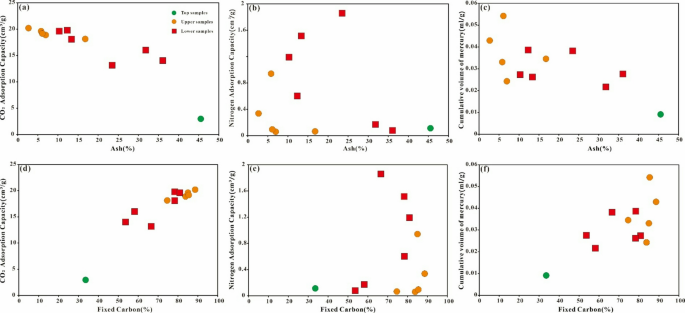
The correlation between carbon dioxide adsorption curve, nitrogen adsorption curve, mercury intrusion curve and ash, fixed carbon. (a) The relationship between ash and CO2 adsorption capacity; (b) The relationship between ash and N2 adsorption capacity; (c) The relationship between ash and mercury intrusion; (d) The relationship between fixed carbon and CO2 adsorption capacity; (e) The relationship between fixed carbon and N2 adsorption capacity; (f) The relationship between fixed carbon and mercury intrusion.
According to previous studies, coal pores can be divided into four categories according to their origin: primary pores, metamorphic pores, exogenous pores, and mineral pores61. Primary pores are those that existed during coal deposition, and mainly include cellular pores and inter-chip pores. A cell cavity pore (or plant tissue pore) is a cell structure pore of the coal-forming plant itself, while an inter-chip pore refers to various detrital microscopic bodies in the coal. When there is an increase in ash content, a large number of argillaceous minerals fill primary pores and block micropores; hence, the micropore content is reduced and the adsorption performance deteriorates.
In terms of secondary micropores left by the generation, accumulation, and gaseous dissipation of coalbed methane during coal metamorphism, previous studies have shown that most of these are filled with adsorbed gas. Primary pores and stomata are common in the vitrinite group, and because the plant cell cavity in the vitrinite group is relatively intact, the pore size is generally small, often dominated by transition pores and micropores. If the vitrinite content of a coal sample is high, the coalbed methane adsorption and storage capacity of the sample is also high. Thus, porosity is positively correlated with vitrinite content, while inertinite has a weak hydrocarbon generation ability62. The data presented herein revealed that the ash content was low in areas of the coal seam with high vitrinite content (Fig. 3). Hence, higher secondary porosity equates to better hydrocarbon generation ability, accompanied by a higher vitrinite content, and lower ash content. Therefore, in general, micropore content is negatively correlated with ash content and positively correlated with fixed carbon content. Through our investigations reported herein, we found that ash content was higher in the lower and topmost layers, and lower in the upper layer of the Benxi coal seam. Therefore, micropores in the upper layer are well developed, contain a large amount of adsorbed gas, and have good reservoir properties.
The development of pores is related to the composition, rank, and sedimentary environment of coal. Vitrinite contains a large number of pores, so the development of micropores in the upper layer of the coal seam is better than that in the lower layer; this is consistent with the sedimentary environment characteristics of the upper layer, being a reducing stable environment, with a high vitrinite content and low ash content. Hence, the upper layer contains a large number of pores, indicating a high hydrocarbon generation material basis and high gas generation capacity.
Mesopores are weakly developed in Benxi coal (Fig. 6). The main reason for this is that the samples in the study area are highly mature and its Ro value is about 1.4%, indicating that mesopores will have been gradually destroyed and filled via compaction. Vitrinite mainly contains micropores, while mesopores and macropores are mainly developed in inertinite63. Samples in this study area are mainly composed of vitrinite; hence, the development of mesopores is generally poor.
There is no evident correlation of mesopores with ash or fixed carbon contents (Fig. 12b and e). For mesopores of 2–50 nm, atomic force microscopy observations have shown that these comprise interchain and molecular pores in coal64. The interchain pores decrease with increasing coal maturity. Molecular pores tend to be larger than interchain pores, mainly concentrated in the size range of 2–50 nm. Qin et al.65 also pointed out that with an increase in coal rank, owing to the continuous reduction of coal side chains and gradual and orderly arrangement of coal macromolecules, the gap between molecules is squeezed, resulting in the gradual reduction of intermolecular pores in coal. This shows that coal mesopores should be closely related to the side chains and basic structural unit gaps in coal molecules, and the formation of mesopores should be controlled by changes in these parameters. Moreover, during weak deformation, structural deformation leads to the degradation and shedding of alkyl side chains and functional groups, resulting in the formation of small molecular free radicals. Some of these exist in mesopores in an adsorbed state, while others are transferred to mesopores and combine with the carbon atomic skeleton of the pore wall, resulting in the destruction of connectivity between mesopores and segmentation of various forms of micropores. Mesopores in raw coal are squeezed by tectonic stress, directional shrinkage occurs to different degrees along the direction perpendicular to the stress action, and differences in pore structure are reduced. During strong deformation, macromolecules are condensed under the action of strong tectonic stress, and the interlayer spacing is reduced, forming a large number of micropores dominated by molecular interlayer pores. Therefore, the formation of mesopores is mainly related to tectonic stress. In turn, the correlations between mesopores and ash and fixed carbon contents are poor66,67.
Figure 12 (c) and (f) shows that the amount of Hg injection is negatively correlated with ash content, and positively correlated with fixed carbon content. This shows that macropores are better developed in coal with less ash content. This is mainly because a high ash content leads to the filling of macropores, thereby reducing the overall macropore content. As shown in Fig. 3, the upper layer was characterized with lower ash content, showing greater abundance of larger pores with less pore filling. As a result, macropores are predominantly concentrated in the upper section of the Benxi coal seam. This contributes to enhanced permeability and the presence of free gas in the upper layer, facilitating the desorption of coalbed methane.
In summary, there are a large number of macropores and micropores in the upper layer of the Benxi coal seam. This shows that, in addition to containing a large amount of adsorbed gas, this layer also contains a large amount of free gas. In addition, the vitrinite content of the upper layer is high and the ash content is low. Therefore, the production potential of the upper coal seam is large, meaning that it should be a key layer for exploration and development.
Microscopic characteristics of pore development
Scanning electron microscopy observations confirmed the heterogeneity of pore distribution. The coal at the very top (Fig. 13a‒c) and lower layer (Fig. 13g‒i) of the Benxi coal seam contains a large number of micropores, including primary porosity and secondary porosity. Some of the primary porosity is filled with large quantities of clay minerals. However, in the upper layer (Fig. 13d‒f), there are a large number of pores that have been subjected to structural changes and destruction. Most of these are plant cell pores and are not filled with clay minerals. Therefore, the porosity of the upper layer is good and has good reservoir performance. In summary, macropores and micropores are mainly developed in the upper layer of Benxi coal. Therefore, the upper layer is an important channel for gas storage and migration, and has favorable reservoir properties.
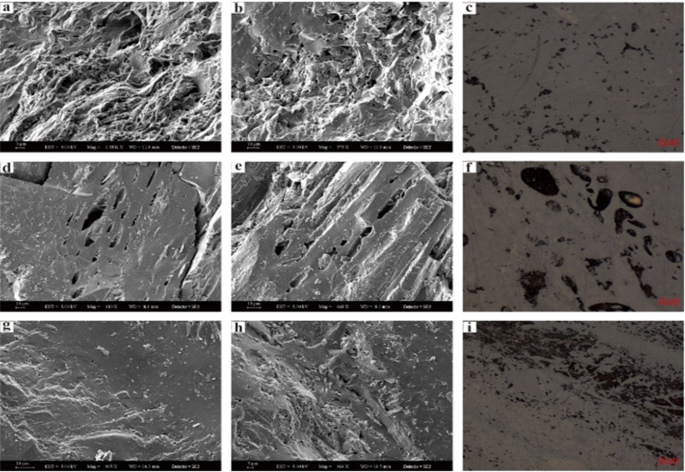
Field emission scanning electron microscope observation photos of Benxi Formation 8 # coal sample. (a) The SEM image of a coal sample with a depth of 2803.5 m (Bar = 3 μm). The content of clay minerals is high, and some primary pores are filled with clay minerals; (b) The SEM image of a coal sample with a depth of 2803.5 m (Bar = 10 μm). A large number of micropores can be seen, some of which are filled with clay minerals; (c) A maceral photo of a coal sample at a depth of 2803.5 m; (d) The SEM image of a coal sample with a depth of 2805.34 m (Bar = 10 μm). A large number of mesopores can be seen, most of which are plant cytoplasmic pores, and are hardly filled with clay minerals; (e) The SEM image of a coal sample with a depth of 2805.34 m (Bar = 10 μm). A large number of pores can be seen, some of which are subjected to structural changes and destruction, and almost not filled with clay minerals; (f) A maceral photo of a coal sample at a depth of 2805.34 m; (g) The SEM image of a coal sample with a depth of 2810.09 m (Bar = 10 μm). It can be found that the pore content is relatively small; (h) The SEM image of a coal sample with a depth of 2810.09 m (Bar = 3 μm). The content of clay minerals is relatively high, and some primary pores are filled with clay minerals; (i) A maceral photo of a coal sample at a depth of 2810.09 m.
Sedimentary model of Benxi coal in the Benxi Formation
In different sedimentary systems, coal seams occur at different locations in genetic stratigraphic units (cycles). It forms a variety of combinations with the roof and the surrounding rock within a certain distance above the roof, forming a variety of coal accumulation environments with a particular distribution law in a region. According to the results reported herein, we can conclude that the Carboniferous Benxi coal seam in the Ordos Basin belongs to the transitional facies coal-bearing series and was a peat flat deposit. Its formation was closely related to changes in sea level. Studies have shown that the climate was mild and humid before this coal-forming period, which was conducive to the development of a large number of plants5. In the Late Carboniferous, owing to tectonic action, the ancient terrain of the study area sank as a whole, and silt depressions were formed in some areas. At this time, due to poor burial conditions, plants were degraded and stable coal seams were not formed. With a rise in sea level, tidal-flat mudstone deposition occurred. Because of tidal action, a large-scale regression occurred in the study area (Fig. 14 ①). The shelf sedimentary facies were exposed to the water surface, and plants continued to grow and gradually occupy the basin. In addition, large-scale regression was accompanied by small-scale transgressive events, resulting in peat swamps in local offshore areas covered by seawater. Here, the soil was prone to swamping, resulting in the formation of nutrient-rich low peat bogs (Fig. 14 ②). Because of the low-lying terrain, there was an abundant water supply, so the peat water became rich in minerals. This was coupled with the mixing of terrigenous debris, so peat accumulated alongside the deposition of a large amount of minerals. At this time, the water body was a active water environment with strong fluidity, and the content of reactive oxygen species in the water body increased. Subsequently, with a further fall in sea level, coastal zones where peat had previously accumulated would have once again accumulated peat, and plants would have further extended their growth to the peat flats (Fig. 14 ③). In this stage, the water body comprised a relatively reducing environment, and the peat flat sedimentary environment was stable. During the later stage of coal formation, sea level rose. The original peat swamp was covered by seawater, and the spreading growth of plants was terminated by seawater inundation; plant growth receded to the tidal flats. At this time, the water body was a deep-water retention reduction environment, and peatification stopped (Fig. 14 ④). Finally, with the occurrence of large-scale transgressive events, previously deposited peat was covered by seawater. In this reducing environment, mudstone, sandstone, and limestone were deposited, and coalification began to occur, ultimately forming coal. The swamp environment of coal-forming becomes a reduced tidal flat environment, indicating the end of coal-forming period (Fig. 14 ⑤).
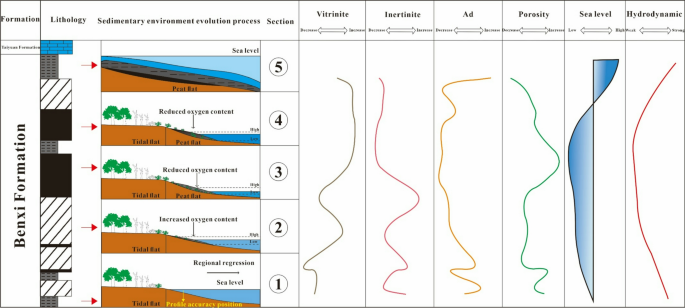
Sedimentary model of Benxi Formation 8 # in Ordos Basin.
After the formation of coal, owing to the influence of the sedimentary environment, the development characteristics of coal reservoir pores in different coal-forming environments were evidently different. In general, primary pores, such as plant structure, and secondary pores were affected during the diagenesis stage. Because of the early oxidizing environment with strong water fluidity in the lower coal seam, the gelatinization effect was weak. This coal phase is dominated by herbaceous plants, and the structure of plant residues is poorly preserved. The content of inertinite in this coal is high and the content of vitrinite low, and the strong hydrodynamic force brought a large quantity of terrigenous debris and minerals, resulting in an increase in ash content, which is not conducive to the development of pores. Therefore, the pore development degree of the lower coal seam layer is low and the connectivity poor, which is inconducive to the storage and migration of coalbed methane. Moreover, owing to the intermittent occurrences of regression and transgression, the water body was unstable. Therefore, the change of each component content is not stable enough, and there are up and down fluctuations. The macroscopic coal types formed were mostly semi-bright coal and bright coal. For the middle portion of the coal seam, the water body became a retention reduction environment due to a medium-term regressive event. The vitrinite content increased and the inertinite content decreased, the hydrodynamic conditions became weaker, and the ash content decreased, which is conducive to the development of pores. Therefore, the coal reservoir properties of this layer are good, and it generally comprises semi-bright coal. Due to a large-scale transgression during the later stage of deposition of the upper coal seam, a large amount of seawater coverage resulted in the formation of a deep-water retentive environment. At this time, the content of vitrinite continued to increase, while the content of inertinite decreased. The water body became a hydrostatic environment, with weak hydrodynamics and low ash content. Therefore, pore development improved, and more macropores and micropores developed, which is conducive to the migration and storage of adsorbed and free gas. Therefore, the upper layer has good reservoir properties and generally comprises bright coal. Because of the late deposition of the roof, the sedimentary environment changed, resulting in the increase of terrigenous materials during the deposition period. The sedimentary argillaceous composition is increased, and the lithology is transformed into mudstone, mostly gangue.
In summary, the lower layer of the Benxi coal seam comprised an active water oxidizing environment with strong activity due to regression and transgression. The inertinite content is high and the vitrinite content is relatively low. The hydrodynamic conditions were strong, ash content is high, and degree of pore development is low. This layer mainly comprises semi-bright coal and is not conducive to gas storage and migration. In contrast, large-scale transgression occurred during deposition of the upper layer, resulting in a stagnant reducing environment. The vitrinite content increased and inertinite content decreased. The hydrodynamic force weakened, ash content decreased, and there was improved pore development. This layer mainly comprises bright coal and has good reservoir properties. The roof is in the late stage of deposition, so a large amount of debris is added during the deposition period, and finally reach the end of the coal-forming stage.
